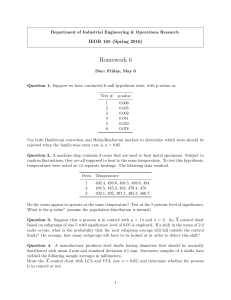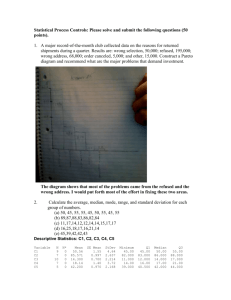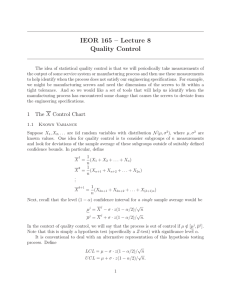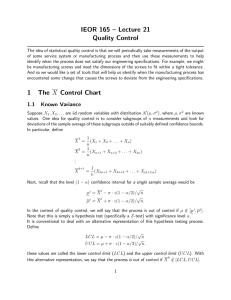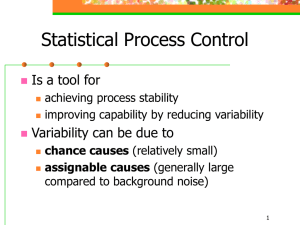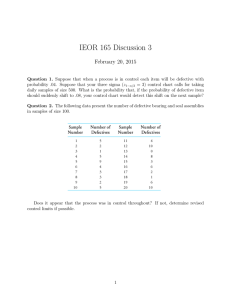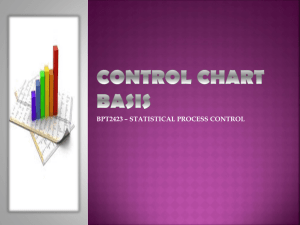Homework 6 IEOR 165 (Spring 2016)
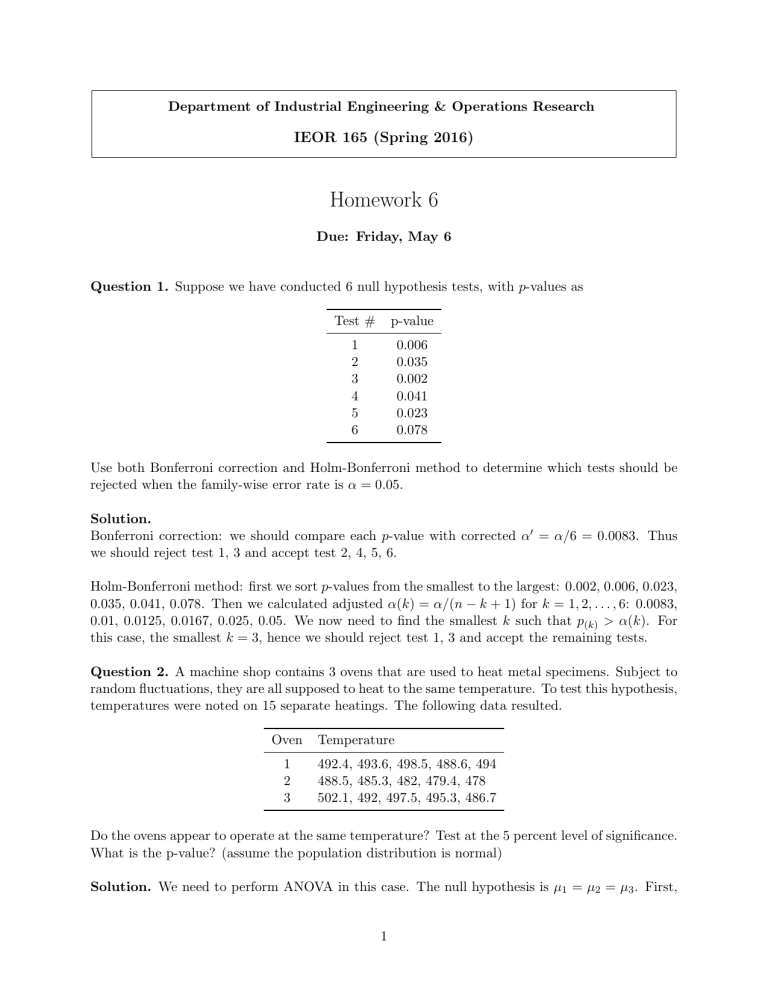
Department of Industrial Engineering & Operations Research
IEOR 165 (Spring 2016)
Homework 6
Due: Friday, May 6
Question 1.
Suppose we have conducted 6 null hypothesis tests, with p -values as
Test # p-value
1
2
3
4
5
6
0.006
0.035
0.002
0.041
0.023
0.078
Use both Bonferroni correction and Holm-Bonferroni method to determine which tests should be rejected when the family-wise error rate is α = 0 .
05.
Solution.
Bonferroni correction: we should compare each p -value with corrected α
0 we should reject test 1, 3 and accept test 2, 4, 5, 6.
= α/ 6 = 0 .
0083. Thus
Holm-Bonferroni method: first we sort p -values from the smallest to the largest: 0.002, 0.006, 0.023,
0.035, 0.041, 0.078. Then we calculated adjusted α ( k ) = α/ ( n − k + 1) for k = 1 , 2 , . . . , 6: 0.0083,
0.01, 0.0125, 0.0167, 0.025, 0.05. We now need to find the smallest k such that p
( k )
> α ( k ). For this case, the smallest k = 3, hence we should reject test 1, 3 and accept the remaining tests.
Question 2.
A machine shop contains 3 ovens that are used to heat metal specimens. Subject to random fluctuations, they are all supposed to heat to the same temperature. To test this hypothesis, temperatures were noted on 15 separate heatings. The following data resulted.
Oven Temperature
1
2
3
492.4, 493.6, 498.5, 488.6, 494
488.5, 485.3, 482, 479.4, 478
502.1, 492, 497.5, 495.3, 486.7
Do the ovens appear to operate at the same temperature? Test at the 5 percent level of significance.
What is the p-value? (assume the population distribution is normal)
Solution.
We need to perform ANOVA in this case. The null hypothesis is µ
1
= µ
2
= µ
3
. First,
1
compute the sample averages as
X
1
= 493 .
42 X
2
= 482 .
64 X
3
= 494 .
72
Then MSG and MSE are
M SG = 219 .
85
M SE = 21 .
55
So p =
P
( F
2 , 12
>
M SG
) =
P
( F
2 , 12
> 10 .
20) = 0 .
0026 < 0 .
05
M SE
Thus we should reject the null hypothesis and conclude that these ovens do not operate at the same temperature.
Question 3.
Suppose that a process is in control with µ = 14 and σ = 2. An X -control chart based on subgroups of size 5 with significance level of 0.05 is employed. If a shift in the mean of 2.2
units occurs, what is the probability that the next subgroup average will fall outside the control limits? On average, how many subgroups will have to be looked at in order to detect this shift?
Solution.
First we calculate the LCL and UCL:
LCL = µ − z (1 − α/ 2) · σ/
√ n = 12 .
247
U CL = µ + z (1 − α/ 2) · σ/
√ n = 15 .
753
If a shift occurs, the distribution is now N (14 ± 2 .
2 , 2). Since the normal distribution is symmetric, we can just compute the probability under the case N (14 + 2 .
2 , 2). With this shift, the subgroup average X will follow a normal distribution N (16 .
2 , 2 / 5). The probability that the next subgroup average will fall outside the control limits is
P
( X < LCL ) +
P
( X > U CL )
=
P
( Z <
LCL − 16 .
2
2 /
√
5
) +
P
( Z >
U CL − 16 .
2
2 /
√
5
)
= P ( Z < − 4 .
42) + P ( Z > − 0 .
500)
= P ( Z < − 4 .
42) + 1 − P ( Z < − 0 .
500) = 0 .
692
On average, we need to look at
1
0 .
692
= 1 .
45 subgroups to detect this shift.
Question 4.
A manufacturer produces steel shafts having diameters that should be normally distributed with mean 3 mm and standard deviation 0.1 mm. Successive samples of 4 shafts have yielded the following sample averages in millimeters.
Subgroup X Subgroup X
1
2
3
4
5
3.02
2.96
3.11
3.15
2.89
6
7
8
9
10
3.02
3.11
3.17
3.06
2.99
2
Draw the X -control chart with LCL and UCL (use α = 0 .
05) and determine whether the process is in control or not.
Solution.
Compute the LCL and UCL:
LCL = µ − z (1 − α/ 2) · σ/
√ n = 2 .
902
U CL = µ + z (1 − α/ 2) · σ/
√ n = 3 .
098
We can conclude that the process is out of control because subgroup 3, 4 ,5, 7, 8 are all exceeding the control limits.
Question 5.
When a certain manufacturing process is in control, it produces items whose values are normally distributed with mean 10 and standard deviation 2. We have drawn 8 successive subgroups of size 5 and their sample averages are shown as below.
Subgroup X
4
5
6
7
8
1
2
3
9.6
10.3
9.9
10.8
10.6
10.4
13.3
9.5
Derive the 5-step moving averages and compute the LCL and UCL for the moving-average control chart with a significance level of 0.05.
Solution.
The solution is shown in the following table.
3
Subgroup X
5
6
7
3
4
1
2
8
M LCL UCL
9.6
9.60
8.247
11.753
10.3
9.95
8.760
11.240
9.9
9.93
8.988
11.012
10.8
10.15
9.123
10.877
10.6
10.24
9.216
10.784
10.4
10.40
9.216
10.784
13.3
11.00
9.216
10.784
9.5
10.92
9.216
10.784
4
